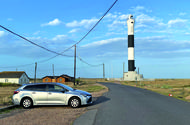Why have a chuntering box for a van if you can have a smart hybrid estate instead?
Why we’re running it: To see if this hybrid can strike the sweet spot between a car and a van
Month 2 – Month 1 – Specs
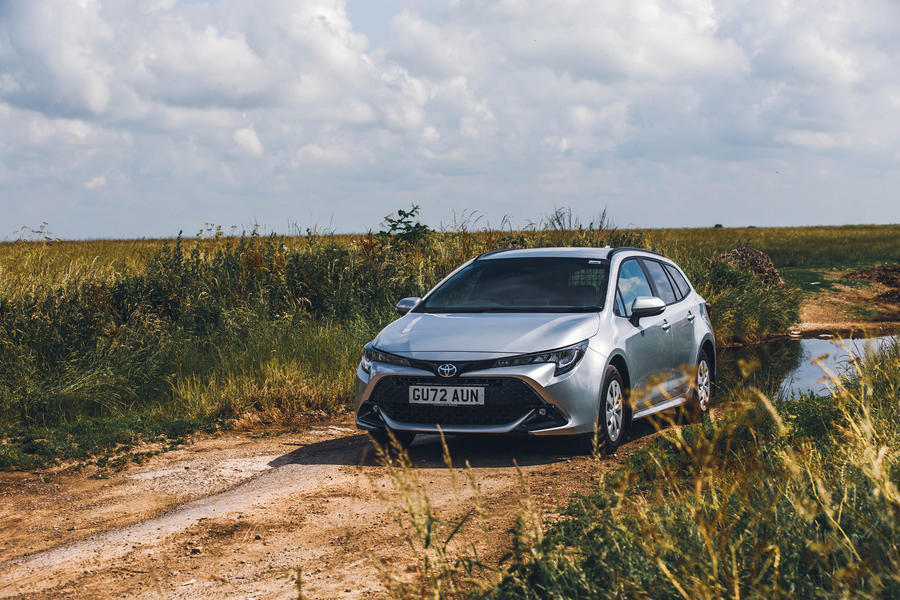
Life with a Toyota Corolla Commercial: Month 2
Of course, practicality is the Commercial’s strong point – 16 August
There are endless cubbyholes in the cabin to stop things rattling about or being left on display, with ample space for your phone, wallet and keys in the centre slot alone. The heated seat switches, just ahead of the gear selector on the centre console, are ideally sited to sneakily turn on your passenger’s one if you are feeling a bit mischievous, too.
Mileage: 5839
Our electrified Corolla is a noisy machine – 2 August
My hybrid van’s electric motors make some very strange noises. They clunk and groan like nothing else I’ve ever been in, even ticking like a well-hidden time bomb every now and then. While I’m on this topic, the noise that emanates from the car at low speeds is actually louder than that from the four-cylinder petrol engine, due to pedestrian safety regulations.
Mileage: 5100
Life with a Toyota Corolla Commercial: Month 1
Lights that alert you to potential danger can sometimes be literally a lifesaver – 26 July
One of my main gripes with modern cars – shared with my colleagues, my family and very nearly everyone I’ve ever talked to about them – is the overzealous warning system that can be an absolute pain in the proverbial to turn off.
In the Corolla, though, the vast majority of these systems just make sense. Included in the £29,440 base price is lane keeping assistance, active cruise control, emergency steering assistance and collision avoidance, all working thanks to a small radar system hidden away behind the front grille. The best part about it? Unlike a few other systems I’ve tried, they actually work and aren’t too overbearing.
The active cruise control is simply sublime. Although it’s initially complicated to activate (you need to hit the buttons in the right order, or you’ll simply be given a pretty unhelpful message telling you to go and check the owner’s manual and come back once you know what you’re doing), it’s one of the best things you could ask for in slow-moving traffic. When active, it takes control of the accelerator and brakes and seriously firms up the steering, gently suggesting to you that you really ought to leave it alone as it knows what it’s doing.
I thought I’d hate not being in total control of it, but it’s so good that I learned to trust it quite quickly. Feel like you’re a bit close to the car in front? Just adjust the distance, easily done from a button on the steering wheel. Want to set it up to go to a higher speed? Again, easily controlled from the wheel. Its only shortcoming is that it’s quite nervous when it comes to overtaking on the motorway. If you’re approaching a car, it will start braking before you reach it unless you pull out incredibly early. Because of this, as nice as adaptive cruise is, I tend to reach for the more traditional speed-set cruise control on fast-moving roads.
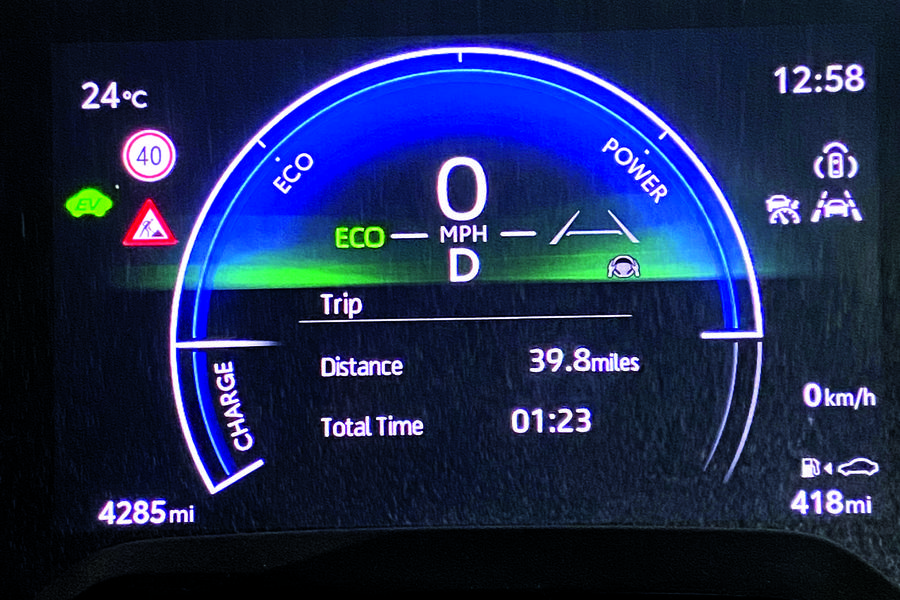
The radar also has other uses. It scans the road ahead for obstacles – pedestrians, parked cars, that sort of thing – and reacts accordingly. While it can be annoying at times (it really likes to go absolutely ballistic when you’re coming up to a parked car on a narrow street, thinking that you’re about to smash right into them), at others it’s a non-hyperbolic lifesaver.
I was driving on an unlit dual carriageway on a pitch-black night, not wanting to use high beams due to the volume of traffic on the other side of the road. Suddenly, the car decided to flash the headlights twice in very quick succession, revealing a cyclist in all black with no lights cruising along the white line. The flash, caused when the radar picked up the hazard about 75m away, allowed me to take evasive action, leaving the all-but-invisible menace unharmed. I dread to think how it might have turned out if I’d been going by the candlelight-rivalling bulbs of my Fiat Coupé…
I’ve also found the auto-hold feature pretty useful. This activates at first when you press a button in the centre console, then in every case when you press the brake pedal all the way down while at a standstill. What’s not useful is how you’ve got to remember to turn it back on whenever you start the car. That gets incredibly annoying incredibly quickly.
What makes it even worse is that every other assist remains set to whatever you chose last time, but this one doesn’t. I’m hardly the most forgetful person, but it keeps catching me out – fine on an empty street, slightly alarming when you start rolling forward while waiting for a gap at a busy roundabout.
Love it
Infotainment set-up
The interior screen is pretty much the perfect size – large enough to see clearly without being overbearing – as well as fast and easy to navigate
Loathe it
Put your foot down!
Our Corolla Commercial’s CVT gearbox has very poor throttle response even with hybrid assistance, making it harder to go for gaps in traffic than it should be.
Mileage: 4867
The Corolla van is spacious, but not all-encasing – 12 July
I was slightly shocked to discover that, due to a high boot floor and narrow wheel arches, my dad’s drum kit and speakers wouldn’t quite fit in the back of the Corolla van, considering that it comfortably fits in his Skoda Octavia Estate. It has redeemed itself by swallowing the contents of a friend’s university flat and their bicycle, though.
Mileage: 4580
Welcoming the Corolla to the fleet – 28 June 2023
Us photographers are an annoying breed: we insist on journalists driving cars out to the middle of nowhere, will always ask for one more pass and will always have a frankly ridiculous amount of kit to hand, just in case.
You would think a van would be our perfect method of transport, then, right? Well, as much kit as we have, they are if anything probably a little too big for us. Plus, thieves have a habit of viewing vans as oversized lucky-dip boxes.
So what do you do if you need a reasonable but not ridiculously large amount of cargo space in an inconspicuous package? You go for a car-based van, such as my new Toyota Corolla Commercial.
From a distance, it looks like a standard Corolla Touring Sports estate. It’s only when you get close that you notice the rear windows are blocked off with a black film (designed to make its van identity as hard to realise as possible) and you realise all is not as it initially seems.
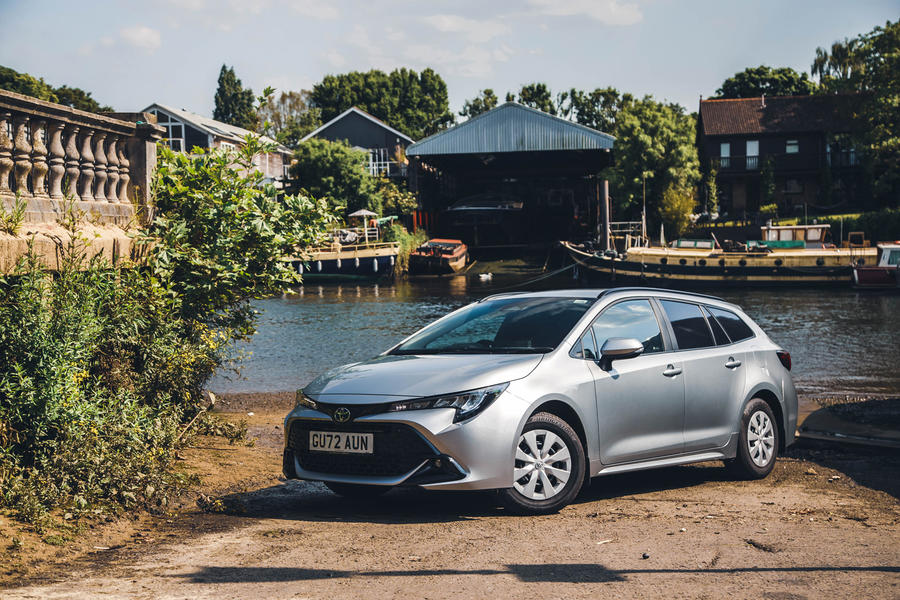
It has the same ‘self-charging’ hybrid system as its rear-seated cousin, with a 1.8-litre four-pot petrol engine, an electric motor and a small battery. That means there’s a total of 138bhp on tap, delivered to the front wheels through an e-CVT.
There’s a fair amount of goodies included for the £24,533 (excluding VAT) base price too, including a rear-view camera, heated seats and an infotainment touchscreen with Apple CarPlay and Android Auto.
Although they are mechanically identical and almost visually so too, the differences between the Corolla car and Corolla van are immediately obvious once you open the latter’s rear doors and find that the back seats are missing (something required by law in order for anything to qualify for commercial vehicle tax benefits).
They have been replaced by a cavernous 1326-litre cargo bay and a full-metal bulkhead grille for separation between the driver and the load being transported. I’m so used to seeing seats inside a car like this that it looks simply massive, but it’s not quite as spacious as even the smallest ‘proper’ vans.
For example, the smallest Toyota Proace City variant has a load bay of 3300 litres, despite being 247mm shorter overall. Still, I’m able to transport objects up to 1860mm long and 1430mm wide.
It’s also worth noting that there’s a normal rear screen. That’s great for driving because the blacked-out side windows create blind spots large enough to lose a medium-size container ship in, but it means that whatever I leave in the back is on full display to the world.
The payload is 435kg, which sounds like a lot until you compare it with the aforementioned Proace City’s 650kg load-lugging capability. Heck, even the standard Corolla estate can carry 100kg more than our new long-termer in certain specifications.
This decreased carrying capacity is offset by the driving characteristics, though. As you would expect, this ‘van’ just feels like a car. The control weights are light around town but the steering is firm and stable at high speeds, while I’ve also been impressed by the quietness, comfort and fuel economy – all things that you want in a vehicle prone to being driven for exceedingly long periods.
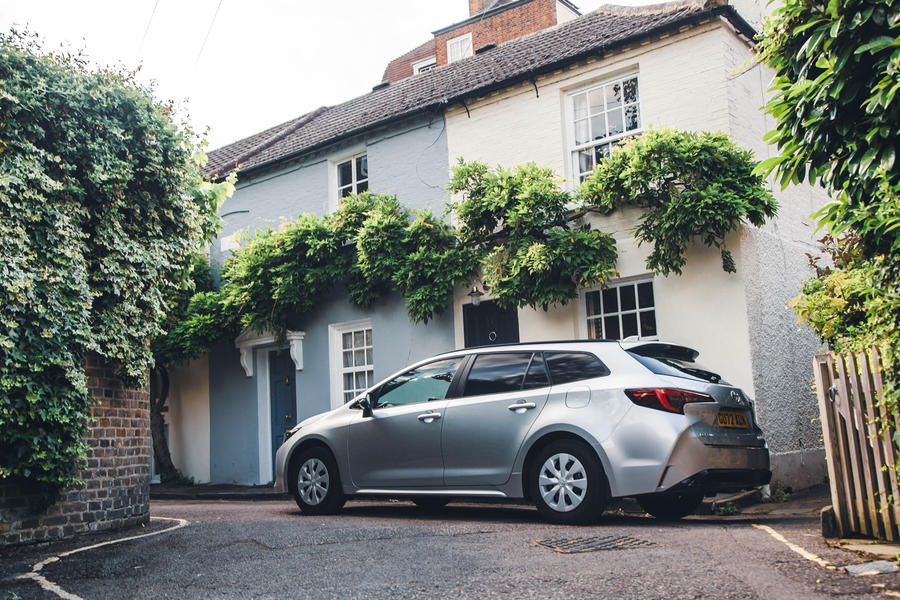
Although it glides smoothly over the appalling roads around my local town of Poole, the rear feels much more softly sprung than the front, giving the car a tendency to rock back and forth for a bit after hitting large bumps. It’s not unpleasant, but it does take a little bit of getting used to.
The radar-guided adaptive cruise control is a real stress-reducer in traffic, as the car does all the work for me, with the incredibly heavy steering and accurate lane keeping assistance seeming like they would be happiest with no human intervention in the slightest.
If that’s not your cup of tea, these two systems can be turned off via the controls on the steering wheel, while other safety equipment such as automatic collision avoidance can be disabled in the menus. Best of all, it remembers your preferences for next time – which isn’t always the case on other cars.
The powertrain is keen to stay in electric mode around town, only really using the combustion engine under acceleration and above speeds of around 30mph, and the power delivery feels incredibly smooth.
The claimed WLTP figure of 64mpg seems somewhat optimistic, but even with my feet of lead, I’ve managed to average 60mpg overall so far, and a recent hour-long motorway run with fairly heavy traffic yielded an incredibly impressive 72.6mpg figure.
So, it’s big, it’s comfy and it’s economical. On first impressions, I’m going to have to try quite hard to find things to moan about during my time with this Toyota, and I doubt that “my dog doesn’t like it” would be a valid criticism.
Second Opinion
Jack’s Corolla is up there with the best vans, mainly because it doesn’t look like one. It does all those vital tasks so easily that it should be a winner for his job. One area where it may come unstuck is passenger room. He and I aren’t blessed in the leg department, yet even for us the seat is just a few inches off the bulkhead.
Piers Ward
Toyota Corolla 1.8 VVT- i Commercial specification
Specs: Price New £29,440 Price as tested £29,956 Options Silver metallic paint, £525
Test Data: Engine 138bhp at 5200rpm Torque 104lb ft at 3600rpm Kerb weight 1410kg Top speed 112mph 0-62mph 11.1sec Fuel economy (claimed) 61mpg CO2 105g/km Faults None Expenses None
Source: Autocar
